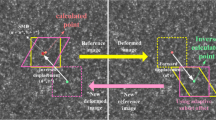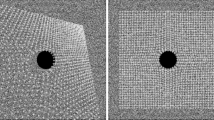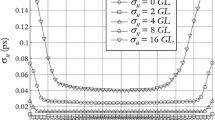Abstract
Optical full-field measurement methods such as Digital Image Correlation (DIC) are increasingly used in the field of experimental mechanics, but they still suffer from a lack of information about their metrological performances. To assess the performance of DIC techniques and give some practical rules for users, a collaborative work has been carried out by the Workgroup “Metrology” of the French CNRS research network 2519 “MCIMS (Mesures de Champs et Identification en Mécanique des Solides / Full-field measurement and identification in solid mechanics, http://www.ifma.fr/lami/gdr2519)”. A methodology is proposed to assess the metrological performances of the image processing algorithms that constitute their main component, the knowledge of which being required for a global assessment of the whole measurement system. The study is based on displacement error assessment from synthetic speckle images. Series of synthetic reference and deformed images with random patterns have been generated, assuming a sinusoidal displacement field with various frequencies and amplitudes. Displacements are evaluated by several DIC packages based on various formulations and used in the French community. Evaluated displacements are compared with the exact imposed values and errors are statistically analyzed. Results show general trends rather independent of the implementations but strongly correlated with the assumptions of the underlying algorithms. Various error regimes are identified, for which the dependence of the uncertainty with the parameters of the algorithms, such as subset size, gray level interpolation or shape functions, is discussed.








Similar content being viewed by others
Notes
For instance, \(\Phi 1 \mbox{\sf I}l\mbox{\sf O}f\mbox{\sf D}16\) corresponds to a DIC formulation with a first order shape function (ϕ = 1), a bi-linear gray level interpolation (i = l), a full optimization (o = f) and a 16 pixels subset size (d = 16).
The authors of the academic codes have participated to this research work and they have run themselves the tests that have lead to the present results.
References
Cloud G (1998) Optical methods of engineering analysis, ISBN 0-521-45087-X. Cambridge University Press, Cambridge
Rastogi P (ed) (1999) Photomechanics, ISBN 3-540-65990-0. Springer, Berlin
Molimard J, Lee J, Surrel Y, Vautrin A (2002) Full-field optical techniques: applications to strain measurement and mechanical identification. In: Invited keynote at the 10th European conference on composite materials (ECCM10). Bruges, Belgium
Surrel Y (2004) Full-field optical methods for mechanical engineering: essential concepts to find one’s way. In: Invited keynote at the 2nd international conference on composites testing and model identification. Bristol, UK
Grédiac M (2004) The use of full-field measurement methods in composite material characterization: interest and limitations. Compos Part A 35:751–761
Sharpe J, William N (eds) (2007) Springer handbook of experimental solid mechanics, ISBN 0-387-30877-6. Springer, Berlin
Patterson E, Hack E, Brailly P, Burguete R, Saleem Q, Siebert T, Tomlinson R, Whelan M (2007) Calibration and evaluation of optical systems for full-field strain measurement. Opt Lasers Eng 45(5):550–564
Patterson E, Brailly P, Burguete R, Hack E, Siebert T, Whelan M (2007) A challenge for high-performance full-field strain measurement systems. Strain 43(3):167–180
Peters W, Ranson W (1982) Digital imaging techniques in experimental stress analysis. Opt Eng 21(3):427–431
Sutton M, Wolters W, Peters W, McNiell S (1983) Determination of displacements using an improved digital correlation method. Image Vis Comput 1:133–139
Bruck H, McNeill S, Sutton M, Peters W (1989) Digital image correlation using Newton–Raphson method of partial differential correction. Exp Mech 29:261–267
Sjödahl M (1994) Electronic speckle photography—increased accuracy by nonintegral pixel shifting. J Appl Opt 33:6667–6673
Sjödahl M (1997) Accuracy in electronic speckle photography. J Appl Opt 36:2875–2885
Choi S, Shah S (1997) Measurement of deformations on concrete subjected to compression using image correlation. Exp Mech 37(3):307–313
Vendroux G, Knauss W (1998) Submicron deformation field: part 2. Improved digital image correlation. Exp Mech 38:85–92
Vacher P, Dumoulin S, Morestin F, Mguil-Touchal S (1999) Bidimensional strain measurement using digital images. J Mech Eng Sci C 213:811–817
Doumalin P, Bornert M, Caldemaison D (1999) Microextensometry by image correlation applied to micromechanical studies using the scanning electron microscopy. In: Proceedings of the international conference on advanced technology in experimental mechanics. Japan Soc. of Exp. Eng., Ube City, Japan, pp 81–86
Sutton M, McNeill S, Helm J, Chao Y (2000) Advances in two-dimensional and three-dimensional computer vision. In: Rastogi P (ed), Photomechanics, topics in applied physics. Springer, Berlin
Wattrisse B, Chrysochoos A, Muracciole J-M, Némoz-Gaillard M (2001) Analysis of strain localization during tensile tests by digital image correlation. Exp Mech 41(1):29–39
Chevalier L, Calloch S, Hild F, Marco Y (2001) Digital image correlation used to analyze the multiaxial behavior of rubber-like materials. Eur J Mech A, Solids 20:169–187
Wang Y, Cuitiño A (2002) Full-field measurements of heterogeneous deformation patterns on polymeric foams using digital image correlation. Int J Solids Struct 39:3777–3796
Abanto-Bueno J, Lambros J (2002) Investigation of crack growth in functionally graded materials using digital image correlation. Eng Fract Mech 69:1695–1711
Laraba-Abbes F, Ienny P, Piques R (2003) A new ’tailor-made’ methodology for the mechanical behaviour analysis of rubber-like materials: I. Kinematics measurements using a digital speckle extensometry. Polymer 44:807–820
Zhang J, Xiong C, Li H, Li M, Wang J, Fang J (2004) Damage and fracture evaluation of granular composite materials by digital image correlation method. Acta Mech Sin 20(4):408–417
Parsons E, Boyce M, Parks D (2004) An experimental investigation of the large-strain tensile behavior of neat and rubber-toughened polycarbonate. Polymer 45:2665–2684
Bergonnier S, Hild F, Roux S (2005) Digital image correlation used for mechanical tests on crimped glass wool samples. J Strain Anal 40(2):185–198
Yoneyama S, Morimoto Y, Takashi M (2006) Automatic evaluation of mixed-mode stress intensity factors utilizing digital image correlation. Strain 42:21–29
Réthoré J, Gravouil A, Morestin F, Combescure A (2005) Estimation of mixed-mode stress intensity factors using digital image correlation and an interaction integral. Int J Fract 132:65–79
MCIMS (2003) Mesures de champs et identification en mécanique des solides/full field measurement and identification in solid mechanics. http://www.ifma.fr/lami/gdr2519/
Schreier H, Braasch J, Sutton M (2000) Systematic errors in digital image correlation caused by intensity interpolation. Opt Eng 39(11):2915–2921
Hild F, Roux S (2006) Digital image correlation: from displacement measurement to identification of elastic properties—a review. Strain 42(2):69–80
Doumalin P (2000) Microextensométrie locale par corrélation d’images numériques; application aux études micromécaniques par microscopie électronique à balayage. PhD thesis, École Polytechnique, Palaiseau, France
Garcia D (2001) Mesure de formes et de champs de déplacements tridimentionnels par stéréo-corrélation d’images. PhD thesis, Institut National Polytechnique de Toulouse, France
Schreier H, Sutton M (2002) Systematic errors in digital image correlation due to undermatched subset shape functions. Exp Mech 43(3):303–311
Knauss WG, Chasiotis I, Huang Y (2003) Mechanical measurements at the micron and nanometer scales. Mech Mater 35(3–6):217–231
Lecompte D, Smits A, Bossuyt S, Sol H, Vantomme J, Van Hemelrijck D, Habraken A (2006) Quality assessment of speckle patterns for digital image correlation. Opt Lasers Eng 44:1132–1145
Réthoré J, Hild F, Roux S (2008) Extended digital image correlation with crack shape optimization. Int J Numer Methosd Eng 73(2):248–272
Orteu J-J, Garcia D, Robert L, Bugarin F (2006) A speckle-texture image generator. In: Proceedings of the Speckle’06 international conference. Nîmes, France
Perlin K (1985) An image synthesizer. In: Proceedings of the SIGGRAPH’85 conference. San Francisco, California, USA, pp 287–296
Rubin D (2004) A simple autocorrelation algorithm for determining grain size from digital images of sediment. J Sediment Res 74(1):160–165
Besnard G, Hild F, Roux S (2006) “Finite-element” displacement fields analysis from digital images: application to Portevin-Le Châtelier bands. Exp Mech 46:789–803
Horn B, Schunk B (1981) Determining optical flow. Artif Intell 17:185–202
Chambon S, Crouzil A (2003) Dense matching using correlation: new measures that are robust near occlusions. In: Proceedings of British machine vision conference (BMVC’2003). East Anglia, Norwich, UK, pp 143–152
Lu H, Ganesan B (2002) Displacement gradient in digital image correlation. In: Proceedings of the 2002 international conference on computational engineering and science
Lu H, Cary P (2000) Deformation measurements by digital image correlation: implementation of a second-order displacement gradient. Exp Mech 40(4):393–400
Aramis 2D software (2008) GOM optical measuring techniques. http://www.gom.com/EN/index.html
Vic-2D software (2008) Correlated Solutions Inc. http://www.correlatedsolutions.com/
Germaneau A, Doumalin P, Dupré J (2007) Full 3D measurement of strain field by scattered light for analysis of structures. Exp Mech 47(4):523–532
Lenoir N, Bornert M, Desrues J, Bésuelle P, Viggiani G (2007) Volumetric digital image correlation applied to X-ray microtomography images form triaxial compression tests on argillaceaous rocks. Strain 43:193–205
Acknowledgements
The authors and all the participants of this benchmark are grateful to the CNRS for supporting this research.
Author information
Authors and Affiliations
Corresponding author
Additional information
Workgroup “Metrology” of the French CNRS research network 2519 “Mesures de Champs et Identification en Mécanique des Solides/Full-field measurements and identification in solid mechanics”. URL: http://www.ifma.fr/lami/gdr2519
Rights and permissions
About this article
Cite this article
Bornert, M., Brémand, F., Doumalin, P. et al. Assessment of Digital Image Correlation Measurement Errors: Methodology and Results. Exp Mech 49, 353–370 (2009). https://doi.org/10.1007/s11340-008-9204-7
Received:
Accepted:
Published:
Issue Date:
DOI: https://doi.org/10.1007/s11340-008-9204-7




